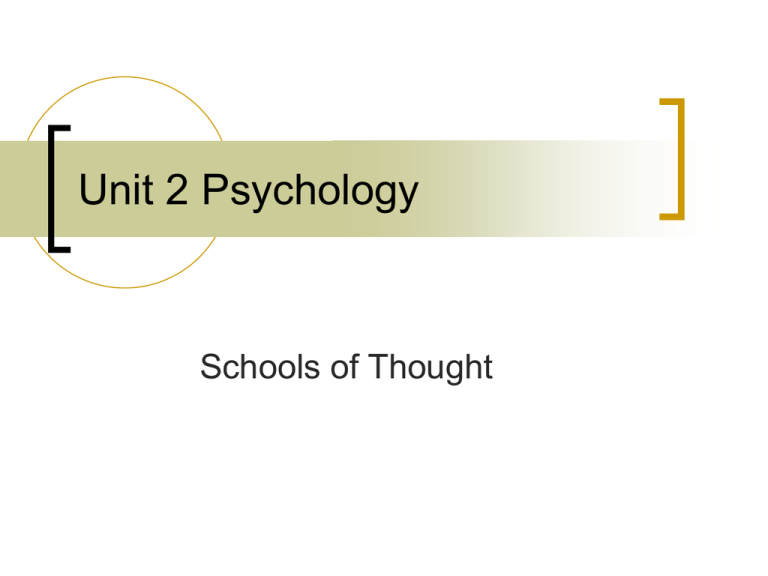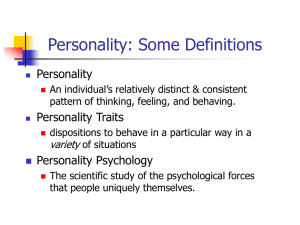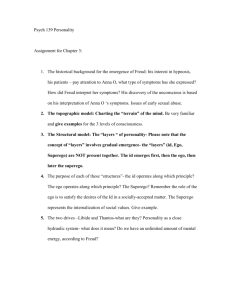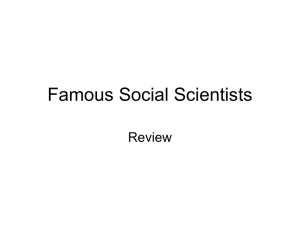School of psychology
advertisement

Unit 2 Psychology Schools of Thought Questions!!! What is personality? What is the mind? What is its relation to the brain? If the mind and the brain are not the same thing but are somehow related, how do your study what you cannot see? How does the mind develop and change over time? Psychodynamic Theorists Psychodynamic Theorists Belief that the key to understanding human behaviour lies in unlocking the unconscious mind Based on Freud’s Psychoanalytic Theory Freud 1856-1939 Based on Freud’s psychoanalysis - to probe the unconscious mind and treat patients anxieties and phobias Studies the inner experiences of the mind through dreams, fantasies, feelings Used to treat trauma and anxiety Freud’s Id, Ego and Superego Freud 1856-1939 Conscious mind Mind Unconscious Mind id ego super ego Assumption: All born with the instinctive impulse to seek pleasure and avoid pain – id (pleasure principle) Superego the moral centre of our brain – acts as our mind’s conscious This instinct my come into conflict with the rational part of the mind, the ego (reality principle) – Which tells us to obey the expectations of society and family. The id and ego battle it out! Personality is the result of which wins, the id or ego, at various points in our lives Acts of the Unconscious Mind Id uses defence mechanism to distort reality in order to deal with anxiety Repress Denial Displace Unlocking the Unconscious Dream and fantasy analysis Free association Methods of resistance and defence mechanism – where patients would often project their feelings onto the therapist – called transference Video Freud part 1 Freud – development theory Stages Age Id’s Pleasure focus Signs in Adulthood that the Id won 1. Oral Birth – 18 m Oral gratification - sucking Putting things in mouth Overeating, smoking, nail-biting 2. Anal 18 m – 3 yrs Bowl pleasure Resisting toilet training Meanness, obsessive neatness, resentment of authority 3. Phallic 3-6 yrs Awareness of sex organs Oedipus /Electra complex Selfishness, poor opposite-sex relationships 4. Latency 6yrs to puberty Same-sex friends Few opposite-sex friends Lack of close friends 5. Genital adolescence Dating Guilt about sexuality, feelings of inadequacy and marriage Sexual energy Freud Criticisms Less accepted today – Inborn, unconscious motivations are less accepted than external factors (no biological proof) Today we have a balanced focus on both nurture and nature Too much emphasis placed on the influence of sexual conflict in childhood Freud said males were normal and females inferior Now we adopt Neo-Freudiamsim – basis of modern psychoanalysis Carl Gustav Jung (1875-1967) Swiss Student of Freud Founder of analytical psychology – a way to understand what motivates us based on both the conscious and unconscious mind Believed that finding balance within the psyche would allow people to reach their full potential Carl Gustav Jung (1875-1967) Swiss Unconscious made of: Individual unconscious Collective unconscious (memories of ancestors shared by all humans regardless of culture) – consisting of certain images and symbols that appear over and over Stones / animals / circles Archetypes Jung determined that these models of people – behaviors and personalities were universal – Archetypes – of the collective unconscious Archetypes connect us to emotions Mother = nurturing and soothing Father = stern, powerful and controlling Hero = courageous champion Trickster = deceptive Jung’s methodologies Like Freud – dreams, and fantacies to understand the unconscious Also used clients art – to gain a greater understanding of the collective unconscious that drives them Jung - Personality Introverted or extroverted Intuition or Sensor Thinker (reason) or Feeler (uses emotion) Perception or Judgment Brian Little on personality Behavioural Psychology Common 1st ½ 20th Century Based on a need for empirical evidence, obtained through experimentation Focus on observable behaviours and phenomena Ivan Pavlov (1849-1936) Father of Behavioural psychology Russian Novel Prize-winner Experimented on dogs Unconditioned Response Unconditioned stimulus Conditioned stimulus Conditioned response Classical conditioning Pavlov’s Classic Conditioning B.F. Skinner (1904-1990) Developed true behaviourism Was concerned with observable behaviours, not the mental processes behind them Operant Conditioning Skinner’s experiment Big Bang Theory Conditioning Humanist Psychology 2nd half 20th century Humanist Psychologist 2nd half 20th century Belief that the client should be involved hi their own recovery, rather than relying only on the therapist’s interpretation of the issue Rejects quantitative methodology –experiments Prefers qualitative research Diary accounts, open unstructured questions and observations Abraham Maslow (1908-1970) Studied those that were well Studied Self-actualizing people and the “peak experiences” Understand how they achieved the status of having reached their full potential Opened doors to new ways of thinking about motivation Viktor Frankl (1905-1997) Experienced Auschwitz Observed that those that survived often had something to hold onto – meaning Logotherapy (study, spirit, God, meaning) proposes that humans are motivated by a need for meaning. Whereas Freud – motivation for pleasure Whereas Adler – motivation for power Humans also have free will meaning you can choose how you respond to a situation – you have the power to shape your own life Carl Rogers (1902-1987) Client-centred therapy approach focuses on the potential of each person to realize their own growth in self-awareness and self-fulfillment Therapist creates a warm safe environment where the client can speak freely without judgment. As clients explore their attitudes and emotions on an issue they discover the underlying motivations for those attitudes Humanistic impacts of society School Student centred /open learning Students: encouraged to take responsibility for their own learning – to be creative / curious Teacher: To understand why students behave the way they do and to learn how to help them achieve growth Principles of Open Education 1. Students will learn best what they want and need to know once they learn the skills to analyze what is important to them and why 2. Knowing how to learn is more important than acquiring lots of knowledge 3. Self-evaluation is the only meaningful evaluation of a student’s work 4. Feelings are as important as facts 5. Students learn best in a non-threatening environment Open education – What does it look like in the classroom? Students get to “do the discipline” rather than simply reading about it Choice in assignment is available Students ideas and interests are used in instruction Cognitive Psychology Cognitive – mental processes Study and application of how the brain learns Believe in and consider mental states – beliefs, motivations and desires. Is often couples with behavioural psychology to create methods of treating people with mental illnesses and neurotic disorders Albert Bandura (1925-) Wondered why the same situation could generate different responses from different people or even the same person Believes people learn behaviour by watching and then imitating others. Social-cognitive Theory – a perspective on personality that considers ones motivation, environment and behaviour Bobo doll experiment Conclusions Elizabeth Loftus (1944-) False memories and the flexibility and reliability of repressed memories False Memories in The Visual Age Believes the repressed memories rarely exist and can be created through the power of suggestion Controversial! Lost in the Mall experiment. Gerald Echterhoff found that for 25% of people, the memory of ding something can be created by watching someone else do it on TV 2. Cognitive Development Theory - Piaget continued Stage Age Characteristics (concluded from experiments) 1. Sensorimoter Birth – 2 yrs Learn by touching, egocentric (don’t understand others’ experiences), something exists only when you can see it 2. Preoperational 2-7 yrs Understands symbols, understands that things can exist when you can’t see them (including concepts cat, dog), Can’t understand why others can be right and they, wrong 3. Concrete operational 7-11 yrs Have logic - understand principles of measurement and size, quantities may be equal although arranged differently 4. Formal operational 11 yrs + Think abstractly – “on my right-hand side”, recognize other’s experiences and that others may by right or wrong








